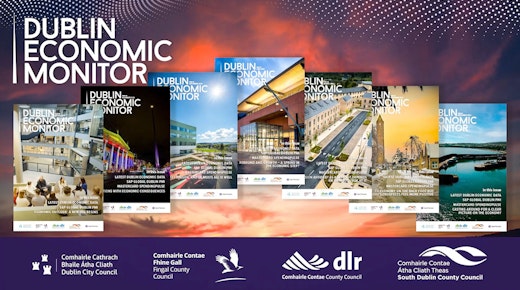Since 2018 a new local government and higher education network has been emerging in the region between Dublin and Belfast.
The network of eight local authorities (four on each side of the border) came together with a shared recognition of both the potential benefits that could arise from cooperation, and the challenges that may arise in the coming years – not least from the outcome of Brexit.
Economic and Demographic Strengths
The region has historically been a centre for economic and population concentration on the island. A joint research report, commissioned by the 8 Local Authorities and completed by University of Ulster and DCU, has shown how the strengths – in particular the road and rail infrastructure, and levels of entrepreneurship and innovation – have emerged over a long time.
A key strength of the Corridor region is its 2 million population and the spatial concentration, educational attainment and diversity of this.
A key strength of the Corridor region is its 2 million population and the spatial concentration, educational attainment and diversity of this. The population is younger than elsewhere on the island, a third are educated to university level and more than 15% were not born in Ireland. By 2040, a third of the island’s population could live on the Corridor. This presents its own challenges, not least sustainable housing and transport solutions.
Inward Investment
The other key strength is the recurrent inward investment in the Corridor. Businesses, particularly multi-nationals, have found the region to be an attractive proposition and returned for repeat business. Dublin and Belfast are key to this success but the other council areas have seen spillovers from this too.
Employment growth to more than a million jobs has created a demand for high levels of skills. Our report, ‘The Dublin-Belfast Economic Corridor: Current Profile, Potential for Recovery & Opportunities for Cooperation’ notes promotional opportunities for the network to build further on decades of success. Tourism, agri-food and emerging industries such as FinTech, cyber-security and high-tech creative could all feature.
We believe that the region has not reached its full potential. Knowledge flows between multinational and domestic firms, between firms and universities, and between different skills levels have been limited. The creation of new ‘soft’ infrastructure, such as shared research centres, ‘smart city’ initiatives and investment in environmental management can create new and inclusive development paths.
A New Initiative
The Corridor initiative was launched online (see www.dbec.info ) in March 2021 by ministers from the Irish and UK Governments and the Northern Ireland Executive. The first steps will be political and public engagement by the network this year to refine priorities for a plan of work to grasp the opportunities identified in the report.
Part of our research looks at other places and their cross-border economic corridors. The Oresund region has become best known for the bridge linking Denmark and southern Sweden. But growth there is about much more than a transport link. Networks of researchers, cultural links and education exchanges have all developed. Oresund shows how the key to success is effective partnership with all partners getting to know each other and building trust. This is once more developing in the Dublin-Belfast Economic Corridor.
The report researchers are Neale Blair (UU), Jordana Corrigan (TU Dublin), Eoin Magennis (UU) and Deiric Ó Broin (DCU).





